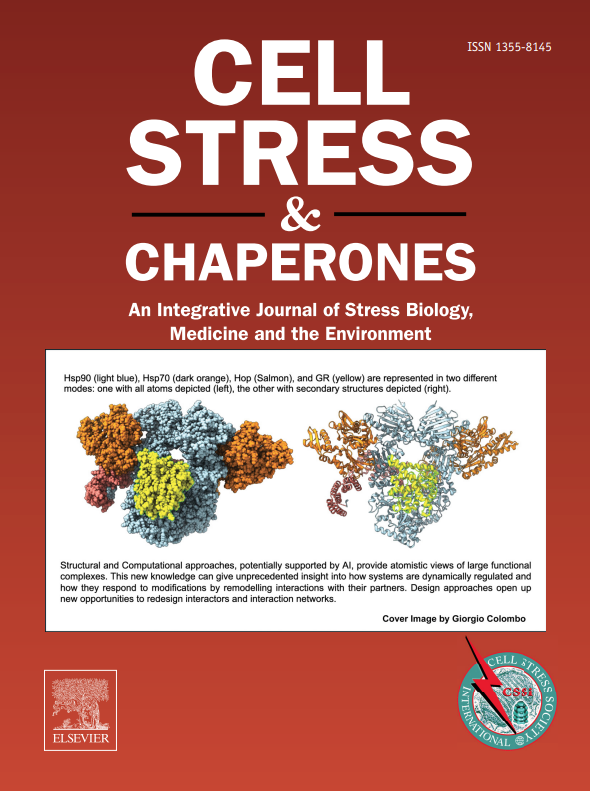HSPA2 emerges as a key biomarker: Insights from global lysine acetylproteomic profiling in idiopathic male infertility
IF 3.2
3区 生物学
Q3 CELL BIOLOGY
引用次数: 0
Abstract
Spermatozoa are highly specialized cells, and any alterations in their protein profiles may affect their function and fertilizing ability. In spermatozoa, which are transcriptionally and translationally inactive, molecular chaperones, particularly heat shock proteins, play crucial roles in maintaining redox balance and preserving protein integrity. Post-translational modifications, particularly lysine acetylation, influence chaperone function and are lately being recognized in the pathophysiology of male infertility. To assess the impact of lysine acetylation on sperm chaperone proteins in idiopathic infertile patients (IIP) compared to fertile donors (FD), we performed immunoprecipitation coupled with liquid chromatography and tandam mass spectroscpy analysis of lysine acetylated sperm proteins from both groups. Proteomic analysis revealed 2988 acetylated proteins, comprising 26 chaperone proteins that were differentially expressed, with four upregulated and nine downregulated in the IIP group. Functional analyses demonstrated enrichment of these proteins in protein folding, spermatogenesis, and response to oxidative stress. CytoHubba analysis reported key HSP70 family members, HSPA2, HSPA4, and HSPA1A as central hub proteins in protein–protein interaction networks. STRING and Ingenuity Pathway Analysis (IPA) network analyses further highlighted the central regulatory roles of these chaperones, with HSPA2 emerging as a key hub protein based on friendship analysis. Western blot validation revealed hypoacetylation and downregulation of HSPA2 in spermatozoa from the IIP group, accompanied by elevated levels of 4-Hydroxynonenal (4-HNE), indicating a link between redox imbalance and altered lysine acetylation in chaperone proteins. Additionally, intense aniline blue staining of sperm nuclei in the IIP group suggested aberrant spermiogenesis. Considering HSPA2′s well-documented involvement in sperm maturation and oocyte recognition, its diminished acetylation and expression may not only act as a potential biomarker but also contribute mechanistically to the development of idiopathic male infertility. This study underscores the significance of lysine acetylation in HSPA2 in regulating chaperone function and highlights its diagnostic and therapeutic potential in unexplained male infertility.
HSPA2成为特发性男性不育症的关键生物标志物:全球赖氨酸乙酰蛋白组学分析的见解
精子是高度特化的细胞,其蛋白质谱的任何改变都可能影响其功能和受精能力。在精子中,分子伴侣特别是热休克蛋白在维持氧化还原平衡和保护蛋白质完整性方面起着至关重要的作用。翻译后修饰,特别是赖氨酸乙酰化,影响伴侣的功能,最近在男性不育的病理生理学中被认识到。为了评估赖氨酸乙酰化对特发性不孕症患者(IIP)与可育供者(FD)精子伴侣蛋白的影响,我们对两组患者的赖氨酸乙酰化精子蛋白进行了免疫沉淀结合LC-MS/MS分析。蛋白质组学分析显示2988个乙酰化蛋白,包括26个伴侣蛋白,在IIP组中差异表达,4个上调,9个下调。功能分析表明,这些蛋白在蛋白质折叠、精子发生和氧化应激反应中富集。CytoHubba分析报告,HSP70家族关键成员HSPA2、HSPA4和HSPA1A是蛋白-蛋白相互作用网络中的中心枢纽蛋白。STRING和IPA网络分析进一步强调了这些伴侣蛋白的中心调控作用,基于友谊分析,HSPA2成为关键的枢纽蛋白。Western blot验证显示,IIP组精子中HSPA2低乙酰化和下调,并伴有4-羟基壬烯醛(4-HNE)水平升高,表明氧化还原失衡与伴侣蛋白赖氨酸乙酰化改变之间存在联系。此外,IIP组精子核苯胺蓝染色强烈提示精子发生异常。考虑到HSPA2参与精子成熟和卵母细胞识别,其乙酰化和表达的减少可能不仅是一种潜在的生物标志物,而且在机制上有助于特发性男性不育症的发展。本研究强调了HSPA2中赖氨酸乙酰化在调节伴侣蛋白功能中的重要性,并强调了其在不明原因男性不育症中的诊断和治疗潜力。
本文章由计算机程序翻译,如有差异,请以英文原文为准。
求助全文
约1分钟内获得全文
求助全文
来源期刊

Cell Stress & Chaperones
生物-细胞生物学
CiteScore
7.60
自引率
2.60%
发文量
59
审稿时长
6-12 weeks
期刊介绍:
Cell Stress and Chaperones is an integrative journal that bridges the gap between laboratory model systems and natural populations. The journal captures the eclectic spirit of the cellular stress response field in a single, concentrated source of current information. Major emphasis is placed on the effects of climate change on individual species in the natural environment and their capacity to adapt. This emphasis expands our focus on stress biology and medicine by linking climate change effects to research on cellular stress responses of animals, micro-organisms and plants.
 求助内容:
求助内容: 应助结果提醒方式:
应助结果提醒方式:


